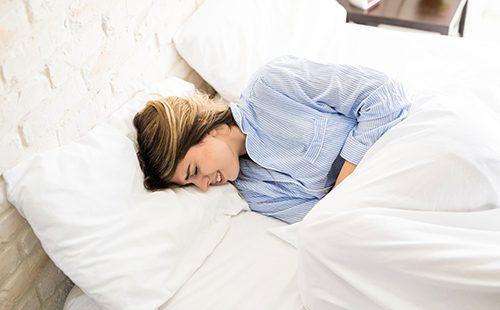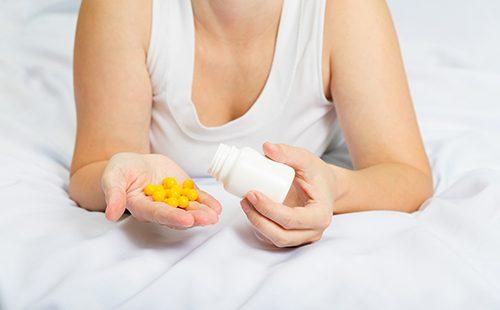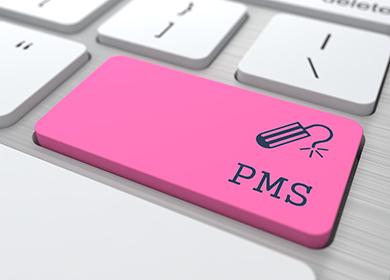The content of the article
According to various sources, up to 75% of women suffer from PMS. He rarely appears in the first years of menstruation, but already in 18-29 years affects up to 20% of women, after 30 years, 47% are already familiar with him, and after 40 years - 55%. The problem of the condition is a variety of symptoms. This forces women to turn to medical doctors, endocrinologists, neurologists, psychotherapists, and only last but not least to gynecologists.
Risk group
PMS is called a disease of civilization. More often affects urban residents engaged in intellectual activities than women who work with physical effort. The risk increases in the following cases:
- age over 40;
- stress and nervous stress;
- frequent pregnancies;
- sexual dissatisfaction;
- miscarriages and frequent abortions;
- history of severe toxicosis during pregnancy;
- severe adverse reactions to COCs (combined oral contraceptives);
- head injuries;
- neuroinfection;
- inflammatory diseases of the genital organs;
- obesity;
- lack of physical activity;
- malnutrition and hypovitaminosis;
- lack of daily routine, adequate rest.
Reasons for the condition
The exact causes of the condition have not yet been established. However, some medical theories have been developed to explain the mechanism of symptom development.
- Hormonal. It is believed that premenstrual disease appears in women with a violation of the ratio of sex hormones in the second phase of the cycle. In the body there is a lack of progesterone and an excess of estrogen. However, other studies have shown that hormone concentrations are often within normal limits. There is evidence that it is not the lack of progesterone that affects, but the features of its metabolism in the central nervous system.
- Allergic. The theory is based on data on a special hypersensitivity reaction to its own progesterone. It is proved by staging intradermal samples in the post-ovulatory phase of the cycle.
- Water intoxication. Presumably, under the influence of stress hormones, the synthesis of adrenocorticotropic hormone increases, which leads to an increase in aldosterone. The latter contributes to fluid retention by the kidneys, so swelling appears, chest hurts.
- Pathology of the exchange of neurotransmitters. Congenital or acquired instability in the hypothalamus-pituitary-ovary system, manifested as a functional disorder of the nervous system. It is also associated with a defect in the metabolism of serotonin, which explains the appearance of depression, a depressed state.
- Hyperadrenocortical Activity. Estrogens can increase the activity of the renal hormone renin.This triggers a mechanism for enhancing the functions of a whole chain of biologically active substances, which leads to sodium retention, but an increased loss of potassium and calcium, which results in fluid stagnation.
Types of manifestations of pathology
The onset of premenstrual disease is individual. In some women, this is one to two days on the eve of menstruation, but in severe cases, manifestations are recorded within 14 days.
A characteristic feature of PMS, which helps to distinguish pathology from diseases of other organs, is the cyclical appearance of symptoms. They begin to bother after ovulation and continue until menstruation.
The severity of the pathology depends on the number of signs and the time of their manifestation.
- Light form. Three to four symptoms are observed two to ten days before menstruation. One or two signs are more pronounced.
- Heavy form. Five to 12 symptoms begin to bother 3-14 days before menstrual bleeding. Of these, five to eight symptoms are strongly manifested.
If PMS is accompanied by disability, this allows the syndrome to be attributed to a severe degree of course.
The disease proceeds in stages. If treatment is not performed at the initial stages, then the pathology intensifies over the years. The following stages are distinguished.
- Compensated. The disease begins in the luteal phase, and its symptoms disappear with the onset of menstrual bleeding.
- Subcompensated. The severity of the manifestations of pathology increases over the years. But they disappear with the onset of menstruation.
- Decompensated. Gaps without pathological symptoms gradually erase, the severity of the disease is growing. Signs of the syndrome are disturbing even during menstruation.
Four clinical forms of pathology are distinguished, the signs of which are reflected in the table.
Table - Clinical forms of PMS
| The form | Characteristic signs |
|---|---|
| Edematous | - Swelling of the face, legs, arms; Bloating; - pain and engorgement of the chest; - weight gain from 4 to 8 kg; - skin itching; - sometimes local edema (anterior abdominal wall, knees, feet); - soreness in the joints, lower back; - negative diuresis |
| Neuropsychic | - irritability; - tearfulness; - a sharp change in mood; - suicidal thoughts; - depression; - auditory and olfactory hallucinations; - memory loss; - aggression; - insomnia; - headaches; - poor appetite or, conversely, hyperphagia; - dizziness; - decreased libido and loss of interest in sex |
| Cephalgic | - Migraine headaches with nausea, vomiting and diarrhea; - tachycardia; - a feeling of pressure or tingling in the heart; - dizziness; - insomnia; - increased susceptibility to odors; - irritability |
| Crisis | - It proceeds as sympatho-adrenal crises; - jumps in blood pressure; - heartache; - fear of death; - strong urination after an attack |
The appearance of a cephalgic form is associated with neuroinfections, a history of head injuries, or mental stress. The crisis form is the result of untreated any other form of PMS that appears after 40 years. It can be combined with pathology of the heart and blood vessels, digestive tract or kidneys.
Rarely, the disease is atypical in the form of such forms:
- hyperthermic - increase in body temperature in the luteal phase of the cycle;
- hypersomnic - pathological drowsiness before menstruation;
- ophthalmoplegic - one-sided closing of the eye with severe migraine pain;
- cyclic allergic reaction - stomatitis, bronchial asthma, iridocyclitis.
Some authors distinguish severe manifestations in the group of premenstrual dysphoric syndrome. Such a diagnosis is made in the presence of five of the 11 signs of PMS. They may be as follows:
- depression;
- signs of anxiety;
- mood swings;
- aggressiveness, irritability;
- impaired appetite;
- insomnia;
- joint pain
- swelling
- change in body weight;
- violation of self-control;
- lack of interest in life.

Diagnostics
Given the variety of manifestations, it is difficult to establish a diagnosis. For this, it is important to consider that the signs of the disease appear cyclically and have a pronounced relationship with menstruation. It helps in the diagnosis to maintain a special diary in which all changes in the condition are made on the days of the cycle.
Diagnosis is based on the exclusion of organic and functional disorders that have similar symptoms. For this, doctors of other specialties can be connected. The choice of diagnostic method depends on the form of the ICP.
- Edematous. It is necessary to study the excretory function of the kidneys, tests for creatinine and residual nitrogen. For three to four days, first the follicular and then the luteal phases, daily diuresis is measured. When engorgement of the mammary glands, mammography and ultrasound are performed in the first phase.
- Neuropsychic. Need a review and consultation of a neurologist, psychiatrist. As research methods, craniography, EEG, REG of the cerebral vessels are used.
- Cephalgic. Doing an MRI of the head, EEG, REG of blood vessels of the brain. An examination of the fundus and an assessment of the visual fields by an ophthalmologist are necessary. Radiography of the skull is performed to visualize the region of the Turkish saddle, as well as a picture or CT scan of the cervical spine. Additionally, a neurologist, optometrist, allergist consults.
- Crisis. Differential diagnosis is carried out with pheochromocytoma: the concentration of catecholamines in the blood, urine is examined, ultrasound of the adrenal glands is performed. Control diuresis, blood pressure. EEG, REG, MRI and X-ray of the skull, examination of the fundus are also required. Consult therapist, ophthalmologist, neurologist and psychiatrist.
For all manifestations of PMS, hormone research is needed. The following indicators have diagnostic value:
- estrogens;
- progesterone;
- prolactin;
- testosterone;
- cortisol;
- TTG;
- T4, T3.
Sex hormone tests should be taken in the first and second phases of the cycle, as well as during ovulation. A pelvic ultrasound scan is required, which allows you to evaluate ovarian function, endometrial condition. Additionally, an ultrasound of the thyroid gland can be performed. In the presence of cardiac symptoms - ECG, echocardiography of the heart.
It is sometimes difficult to distinguish PMS from pregnancy. In the initial stages, some women experience pathological drowsiness, the mammary glands are also rude and sore, and mood changes. In this case, it remains only to wait for the appearance of menstrual flow. If the cycle is unstable, delays often occur, then you can accelerate the diagnosis of an interesting position by making an analysis on hCG. This hormone is determined in the blood even before the onset of delay, when rapid tests are ineffective.
Treatment methods
It is very difficult to get rid of premenstrual syndrome on your own. Ignoring the symptoms leads to a gradual progression of the disease and worsening of the condition. Treatment includes several directions.
Herbs
In mild forms of the disease, they can give a small positive effect. But mainly used proven products that are approved by official medicine:
- soothing herbal teas;
- valerian extract;
- motherwort tincture.
However, some women note that the following recipes helped them.
- From edema. Ten days before the start of menstruation, take a decoction ofdandelion roots. For a day you need to prepare a glass of funds and drink it in two divided doses. It is believed that this reduces the severity of edema and pain in the mammary gland.
- To calm. Prepare herbal teas with mint leaves andlemon balmtwigs lavender. This relieves nervous tension, irritability.
- From pain. Jasmine buds and yarrow grass of 30 and 40 g, respectively, are mixed. Pour 800 ml of boiling water for 30 minutes. Take inside, dividing the infusion into three parts. The course of treatment begins seven days before menstruation. This allows you to reduce pain in the abdomen and lower back.
Psychotherapy
This is one of the first methods that official medicine has resorted to. Specialists help alleviate the condition through understanding the essence of the disease. They use auto-training, they teach to restrain negativity and control emotions. Special relaxation techniques and even hypnosis may be prescribed.
Diet
A change in nutrition is necessary in the second phase of the cycle. Diet involves the rejection of products that are able to excite the nervous system, affect the metabolism of neurotransmitters and the digestive tract. It:
- coffee;
- chocolate;
- alcohol;
- salty;
- spicy.
It is also necessary to limit fluid intake. It is recommended to increase the proportion of fruits and vegetables, dairy products of low fat content. And to exclude refractory fats.

Medicines
The choice of drugs depends on the symptoms that prevail in a particular woman. The following groups of drugs help.
- Affecting CNS Metabolism. Improve the functional state of the nervous system "Magne-B6", "Fezam", "Lutsetam". As a plant-derived antidepressant, Gelarium Hypericum is prescribed.
- Improving blood supply. Regulate vascular tone, blood flow, relieve pain. These are such drugs as Pentoxifylline, Troxerutin, Nicergoline, Bilobil.
- Neurotransmitter drugs. Affect the metabolism of dopamine, serotonin, as well as prolactin "Dostinex", "Bromocriptine", "Fluoxetine».
- Immunomodulators and adaptogens. Such drugs as Erbisol, Ubiquinone, Actovegin improve the trophic processes, humoral and cellular immunity.
- Gestagens. They have antiandrogenic, antimineralocorticoid actions. Use Duphaston and Utrozhestan in the second phase of the cycle.
- Oral contraceptives. COCs impose their hormonal background and block ovulation. The absence of a second phase of the cycle eliminates the symptoms of PMS. They use Yarina, Lindinet, Regulon, Marvelon, Jess, Novinet.
- Gonadotropin releasing hormone agonists. Suppress the function of the pituitary gland and lead to a decrease in the concentration of sex hormones. Assign "Buserelin", "Diferelin."
Women who are concerned about PMS need to pay attention to their health. Sometimes others have a false impression of the simplicity of the state, but in reality the situation can be critical. Especially with a combination of premenstrual disease with chronic pathologies that tend to worsen against the background of the syndrome.
Reviews
I also had something similar when I began to accept OK - everything returned to normal. Only from OK then there are other problems ... the coin has 2 sides ...
Olya, http://www.woman.ru/health/woman-health/thread/3914787/
I don’t know how anyone, but the birth didn’t help me either, PMS is terrible .... ((((My stomach hurts, my legs are taken away, I feel sick, but I’m silent about psychosis and hysteria, relief comes after menstruation for a week and a half, and then all over again ….I do not know what to do…
AlenkaSadk, http://www.woman.ru/health/woman-health/thread/3914787/
I also go and “run into” troubles, but it’s good all the same that it lasts 1-2 days before the very beginning of menstruation ... I really feel if I suffered, it means the other day monsters will come. At this time, as soon as I can, I try to control myself. Sometimes I drink motherwort, if I really want to quarrel with someone.
Felicidad, http://club.passion.ru/zhenskoe-zdorove/pms-chto-neuzheli-vseh-tak-t64736.html
During my PMS, my chest hurt very much and mood spikes earlier, a nightmare is simple! my doctor advised me to drink mastopol, I drank it for 2 months, there were no signs of PMS symptoms)
Evgenia Marchenko, https://health.mail.ru/disease/predmenstrualnyi_sindrom/
PMS is a terrible thing. Itself suffered for a long time (about 7 years). The day before menstruation, natural toxicosis began, then aches, terrible abdominal pain and tantrums, tantrums. I started to drink Tri-regol. Super! I drank 3.5 years. This is a lot and now I do not drink. Everything hurts again, but I will drink Remens. They say it helps.
Leeena, http://www.forums.harbor.ru/archive/index.php/t-162.html

